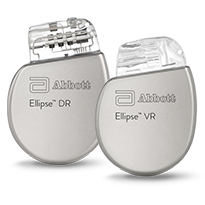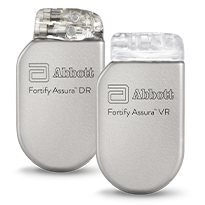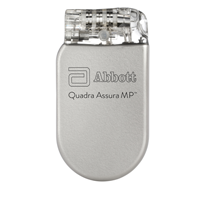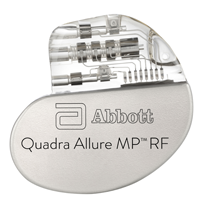Available in all header configurations to improve quality of life for patients in all stages of therapy.
At Abbott, we care about improving your patients' safety, comfort, and quality of life. Our devices elevate the standard of patient care through algorithms and technology intended to improve patient safety and therapy assurance. It is the type of innovation that drives us at Abbott to personalize and optimize therapy for every patient.
Gallant™ ICDs and CRT-Ds
The Gallant ICDs and CRT-Ds offer built-in smartphone connectivity with our latest patient-focused enhancements you can intuitively program to meet your patients' changing needs.
Entrant™ ICDs and CRT-Ds
The Entrant ICDs and CRT-Ds integrate smartphone connectivity with long-lasting therapy in a small, contoured design that is 1.5T and 3T MR Conditional.*
Ellipse™ ICDs
Built for patient safety and comfort, the Ellipse ICD offers small, contoured shape, up to 36 J delivered energy, highly adaptable, non-invasive programming options and wireless remote monitoring with the Merlin@home™ transmitter.
Fortify Assura™ ICDs
The Fortify Assura ICD is an MR Conditional* ICD that offers a unique, narrow shape, combining a powerful delivered output with a very small footprint. Delivering powerful, 40 J delivered energy, the Fortify Assura ICD includes algorithms for automatic vector switching and protection against inappropriate and unnecessary shocks.
Quadra Assura MP™ Cardiac Resynchronization Therapy Defibrillator (CRT-D)
The Quadra Assura MP CRT-D is a CRT-D that offers MultiPoint™ Pacing technology. The Quadra Assura MP CRT-D also offers enhanced programming options, along with multiple monitoring and safety features.
Quadra Allure MP™ Cardiac Resynchronization Therapy Pacemaker (CRT-P)
The Quadra Allure MP CRT-P is a CRT-P with MultiPoint Pacing technology. MultiPoint technology is designed to deliver multiple independent left ventricular (LV) pacing pulses from a single quadripolar lead. The Quadra Allure MP CRT-P also offers automatic tissue site identification, insightful diagnostics and RF monitoring.
Powering Hearts Beat to Beat
Sign up to hear about our technology, education opportunities, and more.
Read the Latest Blog Article
Stay up to date with recent news, product highlights, and case studies.
References
*See MRI Ready Systems Manual for device and lead combinations and associated MRI scan parameters.
Indications, Safety and Warnings
Gallant™/Entrant™ ICDs and CRT-Ds
Rx Only
Brief Summary: Prior to using these devices, please review the Instructions for Use for a complete listing of indications, contraindications, warnings, precautions, potential adverse events and directions for use.
Intended Use: The Implantable Cardioverter Defibrillator (ICD) and Cardiac Resynchronization Therapy Defibrillator (CRT-D) devices are primarily intended for use with compatible leads detect and treat life threatening ventricular arrhythmias by providing ventricular antitachycardia pacing and ventricular cardioversion/defibrillation. In addition, these devices can detect and treat: chronic symptomatic bradyarrhythmia by providing sensing and pacing in the right ventricle; various atrioventricular conduction abnormalities by providing sensing and pacing in the right ventricle and/or right atrium. CRT-D devices sense cardiac activity and provide pacing to resynchronize the right and left ventricles.
The myMerlinPulse™ mobile application is intended for use by people who have an Abbott Medical implanted heart device and access to a mobile device. The app provides remote monitoring capability of the implanted heart device by transmitting information from the patient’s implanted heart device to the patient’s healthcare provider.
Indications: The ICD devices are indicated in patients who have already survived a cardiac arrest or are at a high risk of Sudden Cardiac Death (SCD) due to VT (ventricular tachycardia) or VF (ventricular fibrillation). Cardiac Resynchronization Therapy (CRT) devices are indicated for reduction of symptoms in patients who have congestive heart failure, a reduced left ventricular ejection fraction (LVEF) and a prolonged QRS duration. CRT-D devices are indicated in patients who meet the CRT indications and have already survived a cardiac arrest or are at a high risk of Sudden Cardiac Death (SCD) due to VT (ventricular tachycardia) or VF (ventricular fibrillation). The device is most commonly implanted within a device pocket in the pectoral region.
The myMerlinPulse™ mobile application is indicated for use by patients with supported Abbott Medical implanted heart devices.
Contraindications: Contraindications for use of the pulse generator system include ventricular tachyarrhythmias resulting from transient or correctable factors such as drug toxicity, electrolyte imbalance, or acute myocardial infarction.
The myMerlinPulse™ mobile application is contraindicated for use with any implanted medical device other than supported Abbott Medical implanted heart devices.
Adverse Events: Possible adverse events associated with the implantation of the pulse generator system include the following: Arrhythmia (for example, accelerated or induced), Bradycardia, Cardiac or venous perforation, Cardiac tamponade, Cardiogenic shock, Death, Discomfort, Embolism, Endocarditis, Erosion, Exacerbation of heart failure, Excessive fibrotic tissue growth, Extracardiac stimulation (phrenic nerve, diaphragm, pectoral muscle), Extrusion, Fluid accumulation within the device pocket, Formation of hematomas, cysts, or seromas, Heart block, Hemorrhage, Hemothorax, Hypersensitivity, including local tissue reaction or allergic reaction, Infection, Keloid formation, Myocardial damage, Nerve damage, Occlusion/Thrombus, Pericardial effusion, Pericarditis, Pneumothorax, Pulmonary edema, Syncope, Thrombosis, Valve damage. Complications reported with direct subclavian venipuncture include pneumothorax, hemothorax, laceration of the subclavian artery, arteriovenous fistula, neural damage, thoracic duct injury, cannulation of other vessels, massive hemorrhage and rarely, death. Among the psychological effects of device implantation are imagined pulsing, depression, dependency, fear of premature battery depletion, device malfunction, inappropriate pulsing, shocking while conscious, or losing pulse capability. Possible adverse device effects include complications due to the following: Abnormal battery depletion, Conductor fracture, Device-programmer communication failure, Elevated or rise in defibrillation/cardioversion threshold, Inability to defibrillate or pace, Inability to interrogate or program due to programmer or device malfunction, Incomplete lead connection with pulse generator, Inhibited therapy including defibrillation and pacing, Inappropriate therapy (for example, shocks and antitachycardia pacing [ATP] where applicable, pacing), Interruption of function due to electrical or magnetic interference, Intolerance to high rate pacing (for example dyspnea or discomfort), Lead abrasion, Lead fracture, Lead insulation damage, Lead migration or lead dislodgement, Loss of device functionality due to component failure, Pulse generator migration, Rise in DFT threshold, Rise in pacing threshold and exit block, Shunting of energy from defibrillation paddles, System failure due to ionizing radiation. Additionally, potential adverse events associated with the implantation of a coronary venous lead system include the following: Allergic reaction to contrast media, Breakage or failure of implant instruments, Prolonged exposure to fluoroscopic radiation, Renal failure from contrast media used to visualize coronary veins.
No potential adverse events have been identified with use of the myMerlinPulse™ mobile application.
Ellipse ICD
Single-Chamber
CD1411-36Q Non-Coated
Rx Only
Indications: The devices are intended to provide ventricular antitachycardia pacing and ventricular defibrillation for automated treatment of life-threatening ventricular arrhythmias.
Contraindications: Contraindications for use of the pulse generator system include ventricular tachyarrhythmias resulting from transient or correctable factors such as drug toxicity, electrolyte imbalance or acute myocardial infarction.
Adverse Events: Implantation of the pulse generator system, like that of any other device, involves risks, some possibly life-threatening. These include but are not limited to the following: acute hemorrhage/bleeding, air emboli, arrhythmia acceleration, cardiac or venous perforation, cardiogenic shock, cyst formation, erosion, exacerbation of heart failure, extrusion, fibrotic tissue growth, fluid accumulation, hematoma formation, histotoxic reactions, infection, keloid formation, myocardial irritability, nerve damage, pneumothorax, thromboemboli, venous occlusion. Other possible adverse effects include mortality due to: component failure, device programmer communication failure, lead abrasion, lead dislodgment or poor lead placement, lead fracture, inability to defibrillate, inhibited therapy for a ventricular tachycardia, interruption of function due to electrical or magnetic interference, shunting of energy from defibrillation paddles, system failure due to ionising radiation. Other possible adverse effects include mortality due to inappropriate delivery of therapy caused by: multiple counting of cardiac events including T waves, P waves or supplemental pacemaker stimuli. Among the psychological effects of device implantation are imagined pulsing, dependency, fear of inappropriate pulsing and fear of losing pulse capability.
Refer to the User’s Manual for detailed indications, contraindications, warnings, precautions and potential adverse events.
Ellipse ICD
Dual-Chamber
CD2411-36Q Non-Coated
Rx Only
Indications: The devices are intended to provide ventricular antitachycardia pacing and ventricular defibrillation for automated treatment of life-threatening ventricular arrhythmias.
Contraindications: Contraindications for use of the pulse generator system include ventricular tachyarrhythmias resulting from transient or correctable factors such as drug toxicity, electrolyte imbalance or acute myocardial infarction.
Adverse Events: Implantation of the pulse generator system, like that of any other device, involves risks, some possibly life-threatening. These include but are not limited to the following: acute hemorrhage/bleeding, air emboli, arrhythmia acceleration, cardiac or venous perforation, cardiogenic shock, cyst formation, erosion, exacerbation of heart failure, extrusion, fibrotic tissue growth, fluid accumulation, hematoma formation, histotoxic reactions, infection, keloid formation, myocardial irritability, nerve damage, pneumothorax, thromboemboli, venous occlusion. Other possible adverse effects include mortality due to: component failure, device programmer communication failure, lead abrasion, lead dislodgment or poor lead placement, lead fracture, inability to defibrillate, inhibited therapy for a ventricular tachycardia, interruption of function due to electrical or magnetic interference, shunting of energy from defibrillation paddles, system failure due to ionising radiation. Other possible adverse effects include mortality due to inappropriate delivery of therapy caused by: multiple counting of cardiac events including T waves, P waves or supplemental pacemaker stimuli. Among the psychological effects of device implantation are imagined pulsing, dependency, fear of inappropriate pulsing and fear of losing pulse capability.
Refer to the User’s Manual for detailed indications, contraindications, warnings, precautions and potential adverse events.
Fortify Assura VR ICD
Rx Only
Indications: The devices are intended to provide ventricular antitachycardia pacing and ventricular defibrillation for automated treatment of life-threatening ventricular arrhythmias.
Contraindications: Contraindications for use of the pulse generator system include ventricular tachyarrhythmias resulting from transient or correctable factors such as drug toxicity, electrolyte imbalance or acute myocardial infarction.
Adverse Events: Implantation of the pulse generator system, like that of any other device, involves risks, some possibly life-threatening. These include but are not limited to the following: acute hemorrhage/bleeding, air emboli, arrhythmia acceleration, cardiac or venous perforation, cardiogenic shock, cyst formation, erosion, exacerbation of heart failure, extrusion, fibrotic tissue growth, fluid accumulation, hematoma formation, histotoxic reactions, infection, keloid formation, myocardial irritability, nerve damage, pneumothorax, thromboemboli, venous occlusion. Other possible adverse effects include mortality due to: component failure, device-programmer communication failure, lead abrasion, lead dislodgment or poor lead placement, lead fracture, inability to defibrillate, inhibited therapy for a ventricular tachycardia, interruption of function due to electrical or magnetic interference, shunting of energy from defibrillation paddles, system failure due to ionising radiation. Other possible adverse effects include mortality due to inappropriate delivery of therapy caused by: multiple counting of cardiac events including T waves, P waves or supplemental pacemaker stimuli. Among the psychological effects of device implantation are imagined pulsing, dependency, fear of inappropriate pulsing and fear of losing pulse capability.
Refer to the User’s Manual for detailed indications, contraindications, warnings, precautions and potential adverse events.
Fortify Assura DR ICD
Rx Only
Indications: The devices are intended to provide ventricular antitachycardia pacing and ventricular defibrillation for automated treatment of life-threatening ventricular arrhythmias. Dual-chamber pacing: AF Suppression™ pacing is indicated for suppression of paroxysmal or persistent atrial fibrillation in patients with the above ICD indication and sinus node dysfunction.
Contraindications: Contraindications for pulse generator system use include ventricular tachyarrhythmias resulting from transient or correctable factors such as drug toxicity, electrolyte imbalance and acute myocardial infarction.
Adverse Events: Implantation of the pulse generator system, like that of any other device, involves risks, some possibly life-threatening. These include but are not limited to the following: acute hemorrhage/bleeding, air emboli, arrhythmia acceleration, cardiac or venous perforation, cardiogenic shock, cyst formation, erosion, exacerbation of heart failure, extrusion, fibrotic tissue growth, fluid accumulation, hematoma formation, histotoxic reactions, infection, keloid formation, myocardial irritability, nerve damage, pneumothorax, thromboemboli, venous occlusion. Other possible adverse effects include mortality due to: component failure, device-programmer communication failure, lead abrasion, lead dislodgment or poor lead placement, lead fracture, inability to defibrillate, inhibited therapy for a ventricular tachycardia, interruption of function due to electrical or magnetic interference, shunting of energy from defibrillation paddles, system failure due to ionizing radiation. Other possible adverse effects include mortality due to inappropriate delivery of therapy caused by: multiple counting of cardiac events including T waves, P waves, or supplemental pacemaker stimuli. Among the psychological effects of device implantation are imagined pulsing, dependency, fear of inappropriate pulsing and fear of losing pulse capability.
Refer to the User’s Manual for detailed indications, contraindications, warnings, precautions and potential adverse events.
Quadra Assura™ MP CRT-D
Cardiac Resynchronization Therapy Defibrillator (CRT-D)
Rx Only
Brief Summary: Prior to using these devices, please review the Instructions for Use for a complete listing indications, contraindications, warnings, precautions, potential adverse events and directions for use.
Indications: The devices are intended to provide ventricular antitachycardia pacing and ventricular defibrillation for automated treatment of life-threatening ventricular arrhythmias. Cardiac Resynchronization Therapy Defibrillators (CRT-Ds) are also intended to resynchronize the right and left ventricles in patients with congestive heart failure.
Contraindications: Contraindications for use of the pulse generator system include ventricular tachyarrhythmias resulting from transient or correctable factors such as drug toxicity, electrolyte imbalance or acute myocardial infarction.
Adverse Events: Implantation of the pulse generator system, like that of any other device, involves risks, some possibly life-threatening. These include but are not limited to the following: acute hemorrhage/bleeding, air emboli, arrhythmia acceleration, cardiac or venous perforation, cardiogenic shock, cyst formation, erosion, exacerbation of heart failure, extrusion, fibrotic tissue growth, fluid accumulation, hematoma formation, histotoxic reactions, infection, keloid formation, myocardial irritability, nerve damage, pneumothorax, thromboemboli, venous occlusion. Other possible adverse effects include mortality due to: component failure, device-programmer communication failure, lead abrasion, lead dislodgment or poor lead placement, lead fracture, inability to defibrillate, inhibited therapy for a ventricular tachycardia, interruption of function due to electrical or magnetic interference, shunting of energy from defibrillation paddles, system failure due to ionising radiation. Other possible adverse effects include mortality due to inappropriate delivery of therapy caused by: multiple counting of cardiac events including T waves, P waves or supplemental pacemaker stimuli. Among the psychological effects of device implantation are imagined pulsing, dependency, fear of inappropriate pulsing and fear of losing pulse capability.
Refer to the User’s Manual for detailed indications, contraindications, warnings, precautions and potential adverse events.
Quadra Allure™ MP CRT-P
Rx Only
Brief Summary: Prior to using these devices, please review the Instructions for Use for a complete listing of indications, contraindications, warnings, precautions, potential adverse events and directions for use. Devices depicted may not be available in all countries. Check with your Abbott representative for product availability in your country.
Indications: Implantation of Quadra Allure MP RF device is indicated for: maintaining synchrony of the left and right ventricles in patients who have undergone an AV nodal ablation for chronic atrial fibrillation and have NYHA Class II or III heart failure, the reduction of the symptoms of moderate to severe heart failure (NYHA Class III or IV) in those patients who remain symptomatic despite stable, optimal medical therapy, and have a left ventricular ejection fraction ≤ 35% and a prolonged QRS duration, implantation of Assurity™, Endurity™ and Allure™ family of devices is indicated in one or more of the following permanent conditions: syncope, presyncope, fatigue, disorientation, or any combination of those symptoms.
Rate-Modulated Pacing is indicated for patients with chronotropic incompetence, and for those who would benefit from increased stimulation rates concurrent with physical activity. Dual-Chamber Pacing is indicated for those patients exhibiting: sick sinus syndrome, chronic, symptomatic second- and third-degree AV block, recurrent Adams-Stokes syndrome, symptomatic bilateral bundle branch block when tachyarrhythmia and other causes have been ruled out. Atrial Pacing is indicated for patients with sinus node dysfunction and normal AV and intraventricular conduction systems. Ventricular Pacing is indicated for patients with significant bradycardia and normal sinus rhythm with only rare episodes of A-V block or sinus arrest, chronic atrial fibrillation, severe physical disability. AF Suppression™ algorithm is indicated for suppression of paroxysmal or persistent atrial fibrillation episodes in patients with one or more of the above pacing indications.
Contraindications: Implanted Cardioverter-Defibrillator (ICD). Devices are contraindicated in patients with an implanted cardioverter-defibrillator. Rate-Adaptive Pacing may be inappropriate for patients who experience angina or other symptoms of myocardial dysfunction at higher sensor-driven rates. An appropriate Maximum Sensor Rate should be selected based on assessment of the highest stimulation rate tolerated by the patient. AF Suppression stimulation is not recommended in patients who cannot tolerate high atrial-rate stimulation. Dual-Chamber Pacing, though not contraindicated for patients with chronic atrial flutter, chronic atrial fibrillation, or silent atria, may provide no benefit beyond that of single-chamber pacing in such patients. Single-Chamber Ventricular Demand Pacing is relatively contraindicated in patients who have demonstrated pacemaker syndrome, have retrograde VA conduction, or suffer a drop in arterial blood pressure with the onset of ventricular pacing. Single-Chamber Atrial Pacing is relatively contraindicated in patients who have demonstrated compromise of AV conduction. Atrial Fibrillation Allure™ devices are contraindicated in patients having chronic atrial fibrillation or intermittent atrial fibrillation that does not terminate. For specific contraindications associated with individual modes, refer to the programmer’s on-screen help.
Potential Adverse Events: The following are potential complications associated with the use of any pacing system: air embolism, body rejection phenomena, cardiac tamponade or perforation, hematoma, bleeding hematoma, seroma, formation of fibrotic tissue, local tissue reaction, inability to interrogate or program due to programmer or device malfunction, infection/erosion, interruption of desired pulse generator function due to electrical interference, either electromyogenic or electromagnetic, lead malfunction due to conductor fracture or insulation degradation, loss of capture or sensing due to lead dislodgement or reaction at the electrode/ tissue interface, loss of desired pacing and/or sensing due to lead displacement, body reaction at electrode interface, or lead malfunction (fracture or damage to insulation), loss of normal device function due to battery failure or component malfunction, pacemaker migration or pocket erosion, pectoral muscle or diaphragmatic stimulation, phrenic nerve stimulation, pneumothorax/hemothorax, endocarditis, excessive bleeding, induced atrial or ventricular arrhythmias, myocardial irritability, pericardial effusion, pericardial rub, pulmonary edema, rise in threshold and exit block, valve damage, cardiac/coronary sinus dissection, cardiac/coronary sinus perforation, coronary sinus or cardiac vein thrombosis.
Refer to the User’s Manual for detailed indications, contraindications, warnings, precautions and potential adverse events.
MAT-2502410 v1.0







